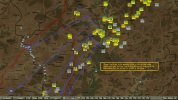lollipop guild
Member
This wasn't a good showing by me at all. In my defence I started panicking a bit about the enemy getting a little too close to the Wiltz objectives in the South, but also I moved a couple of Battalions in the central area off two of the objectives that would have secured 12 VP each which I stupidly wasn't paying attention to and only realised once it was too late. So a bit of a cock-up all round really.
The initial plan of course was to keep the North and South orders more of less the same, which I did, and move some central forces back to the two objectives in the West while also reinforcing the South. Unfortunately for some reason the Battalions I wanted to move West simply refused to move for the entire battle. This was when I, essentially, and very stupidly just plucked a couple of Battalions more or less at random and ordered them West. I'm pretty sure the ones I chose were the two sitting on the 12 VP objectives. If nothing else, this may be a lesson in taking breaks instead of pushing on furiously like an addict getting his fix.
Anyway here's some screenshots for your enjoyment.
The North only differed in the fact that the enemy seemed to push an Engineer unit to the bridge and sat on it. I don't remember this happening last time. And you can see my first mistake was to move a Battalion right past them as if they weren't there at all. I just don't know what I was thinking there. I just needed to attack and push them back.
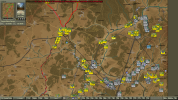
D1 at 1300 hrs in the South this time and things are pretty much as expected. Very similar to last time.
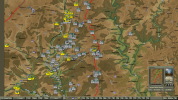
Things begin to heat up a little at 1700 hrs in the North. The Engineer Battalion is starting to edge forward across the bridge. This really was a huge miss on my part and it should have been dealt with much sooner. As it was I left it too late and lost the St. Vith objective the next day.
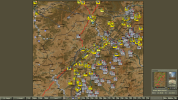
In the South at 1700 hrs, and the enemy are really pushing my beleaguered troops at this point. I've already ordered most of the reinforcements South and they do arrive in time, in fact they're earlier than last time, but once again the enemy seems a little more determined to go on the offensive in this battle. It was shortly after this that I made the mistake of moving the Battalions I mentioned above off their 12 VP objectives without realising.
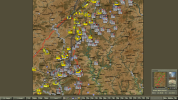
At the end of D2, and the battle, I've lost ground completely starting with St. Vith.
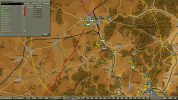
Next to fall are the two central 12 VP objectives.
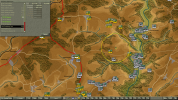
and...

Then we went and lost Wiltz itself too. Oh dear. Not a good couple of days at all.
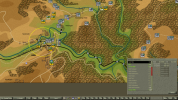
And the final results.
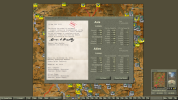
So, all in all a complete f**k-up by me there. I don't have the energy to do it again just yet, but will no doubt come back to it and try a different plan of action once again at some point in the future.
All in all I enjoyed the first battle more. This one was too full of my own mistakes and oversights and I was just glad when it was all over in the end.
Hope you enjoyed this(more succinct) aar anyway. See you next time. Good luck, and have fun.
The initial plan of course was to keep the North and South orders more of less the same, which I did, and move some central forces back to the two objectives in the West while also reinforcing the South. Unfortunately for some reason the Battalions I wanted to move West simply refused to move for the entire battle. This was when I, essentially, and very stupidly just plucked a couple of Battalions more or less at random and ordered them West. I'm pretty sure the ones I chose were the two sitting on the 12 VP objectives. If nothing else, this may be a lesson in taking breaks instead of pushing on furiously like an addict getting his fix.
Anyway here's some screenshots for your enjoyment.
The North only differed in the fact that the enemy seemed to push an Engineer unit to the bridge and sat on it. I don't remember this happening last time. And you can see my first mistake was to move a Battalion right past them as if they weren't there at all. I just don't know what I was thinking there. I just needed to attack and push them back.

D1 at 1300 hrs in the South this time and things are pretty much as expected. Very similar to last time.

Things begin to heat up a little at 1700 hrs in the North. The Engineer Battalion is starting to edge forward across the bridge. This really was a huge miss on my part and it should have been dealt with much sooner. As it was I left it too late and lost the St. Vith objective the next day.

In the South at 1700 hrs, and the enemy are really pushing my beleaguered troops at this point. I've already ordered most of the reinforcements South and they do arrive in time, in fact they're earlier than last time, but once again the enemy seems a little more determined to go on the offensive in this battle. It was shortly after this that I made the mistake of moving the Battalions I mentioned above off their 12 VP objectives without realising.

At the end of D2, and the battle, I've lost ground completely starting with St. Vith.

Next to fall are the two central 12 VP objectives.

and...

Then we went and lost Wiltz itself too. Oh dear. Not a good couple of days at all.

And the final results.

So, all in all a complete f**k-up by me there. I don't have the energy to do it again just yet, but will no doubt come back to it and try a different plan of action once again at some point in the future.
All in all I enjoyed the first battle more. This one was too full of my own mistakes and oversights and I was just glad when it was all over in the end.
Hope you enjoyed this(more succinct) aar anyway. See you next time. Good luck, and have fun.
